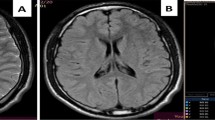Abstract
Introduction
Cerebral fat embolism syndrome (CFES) mimics diffuse axonal injury (DAI) on MRI with vasogenic edema, cytotoxic edema, and micro-hemorrhages, making specific diagnosis a challenge. The objective of our study is to determine and compare the diagnostic utility of the conventional MRI and DTI in differentiating cerebral fat embolism syndrome from diffuse axonal injury.
Methods
This retrospective study was performed after recruiting 11 patients with severe CFES and ten patients with severe DAI. Three trauma radiologists analyzed conventional MR images to determine the presence or absence of CFES and DAI. DTI analysis of the whole-brain white matter was performed to obtain the directional diffusivities. The results were correlated with clinical diagnosis to determine the diagnostic utility of conventional MRI and DTI.
Results
The sensitivity, specificity, and accuracy of conventional MRI in diagnosing CFES, obtained from the pooled data were 76, 85, and 80 %, respectively. Mean radial diffusivity (RD) was significantly higher and the mean fractional anisotropy (FA) was lower in CFES and differentiated subjects with CFES from the DAI group. Area under the receiver operating characteristic (ROC) curve for conventional MRI was 0.82, and for the differentiating DTI parameters the values were 0.75 (RD) and 0.86 (FA), respectively.
Conclusions
There is no significant difference between diagnostic performance of DTI and conventional MRI in CFES, but a difference in directional diffusivities was clearly identified between CFES and DAI.



Similar content being viewed by others
References
Muller C, Rahn BA, Pfister U, Meinig RP (1994) The incidence, pathogenesis, diagnosis, and treatment of fat embolism. Orthop Rev 23:107–117
Parizel PM, Demey HE, Veeckmans G et al (2001) Early diagnosis of cerebral fat embolism syndrome by diffusion-weighted MRI (Starfield Pattern). Stroke 32:2942–2944
Pfeffer G, Heran MK (2010) Restricted diffusion and poor clinical outcome in cerebral fat embolism syndrome. Can J Neurol Sci 37(1):128–130
Johnson MJ, Lucas GL (1996) Fat embolism syndrome. Orthopedics 19(1):41–49
Talbot M, Schemitsch EH (2006) Fat embolism syndrome: history, definition, epidemiology. Injury 37(Suppl 4):S3–S7
Jacobson DM, Terrence CF, Reinmuth OM (1986) The neurologic manifestations of fat embolism. Neurology 36(6):847–851
Bardana D, Rudan J, Cervenko F, Smith R (1998) Fat embolism syndrome in a patient demonstrating only neurologic symptoms. Can J Surg 41(5):398–402
Citerio G, Bianchini E, Beretta L (1995) Magnetic resonance imaging of cerebral fat embolism: a case report. Intensive Care Med 21(8):679–681
Stoeger A, Daniaux M, Felber S, Stockhammer G, Aichner F, Zur Nedden D (1998) MRI findings in cerebral fat embolism. Eur Radiol 8(9):1590–1593
Takahashi M, Suzuki R, Osakabe Y et al (1999) Magnetic resonance imaging findings in cerebral fat embolism: correlation with clinical manifestations. J Trauma 46(2):324–327
Chrysikopoulos H, Maniatis V, Pappas J, Filalithis P, Gogali C, Sfyras D (1996) Case report: post-traumatic cerebral fat embolism: CT and MR findings. Report of two cases and review of the literature. Clin Radiol 51(10):728–732
Huisman TA, Sorensen AG, Hergan K, Gonzalez RG, Schaefer PW (2003) Diffusion-weighted imaging for the evaluation of diffuse axonal injury in closed head injury. J Comput Assist Tomogr 27(1):5–11
Kamenar E, Burger PC (1980) Stroke 11(5):477–484
Gurd AR, Wilson RE (1974) The fat embolism syndrome. J Bone Joint Surg Br 56B(3):408–416
Smith SM (2002) Fast robust automated brain extraction. Hum Brain Mapp 17(3):143–155
Smith SM, Jenkinson M, Woolrich MW et al (2004) Advances in functional and structural MR image analysis and implementation as FSL. Neuroimage 23 Suppl 1:S208–219
Kim HJ, Lee CH, Lee SH (2001) Early development of vasogenic edema in experimental cerebral fat embolism in cats: correlation with MRI and electron microscopic findings. Invest Radiol 36(8):460–469
Kim HJ, Lee CH, Lee SH, Moon TY (2003) Magnetic resonance imaging and histologic findings of experimental cerebral fat embolism. Invest Radiol 38(10):625–634
Mac Donald CL, Dikranian K, Bayly P, Holtzman D, Brody D (2007) Diffusion tensor imaging reliably detects experimental traumatic axonal injury and indicates approximate time of injury. J Neurosci 27(44):11869–11876
Nagesh V, Welch KM, Windham JP (1998) Time course of ADCw changes in ischemic stroke: beyond the human eye! Stroke 29(9):1778–1782
Schlaug G, Siewert B, Benfield A, Edelman RR, Warach S (1997) Time course of the apparent diffusion coefficient (ADC) abnormality in human stroke. Neurology 49(1):113–119
Acknowledgment
The authors thank Brigitte Pocta for reviewing the manuscript.
Conflict of interest
We declare that we have no conflict of interest.
Author information
Authors and Affiliations
Corresponding author
Rights and permissions
About this article
Cite this article
Bodanapally, U.K., Shanmuganathan, K., Saksobhavivat, N. et al. MR imaging and differentiation of cerebral fat embolism syndrome from diffuse axonal injury: application of diffusion tensor imaging. Neuroradiology 55, 771–778 (2013). https://doi.org/10.1007/s00234-013-1166-5
Received:
Accepted:
Published:
Issue Date:
DOI: https://doi.org/10.1007/s00234-013-1166-5




